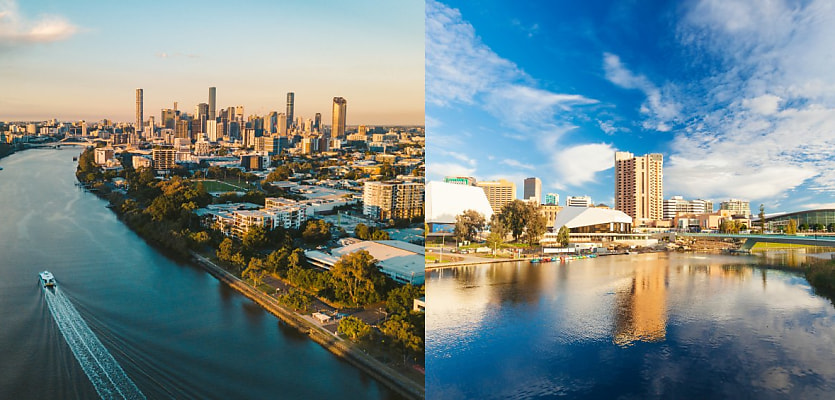While the era of strong price growth has ended for Australia as a whole, Brisbane and Adelaide have emerged as the last strongholds amid the market downturn sweeping across the country.
Knight Frank’s Global House Price Index — which tracks the movement of average house prices across 56 countries globally — showed that Australia’s housing market saw house prices fall by 0.8 per cent.
The figures represent the country’s third-largest decline in prices on a three-month basis and put the Land Down Under behind its peers as one of the seven countries to record a drop in property values over the period.
The report noted that while prices in the Asia-Pacific region are at the forefront of the anticipated downturn in the world’s property markets, global markets are generally showing signs of resilience.
Overall, the global index has risen by 10 per cent at an annual rate, with 51 of the 56 tracked countries continuing to register an increase in house prices. Knight Frank noted that the strong annual performance was delivered despite expectations of a notable slowdown in the second quarter due to recession fears, energy prices, rate rises and geopolitical concerns.
However, when taking the surging inflation into account, global house prices in real terms are averaging just 1.6 per cent growth in the year to the second quarter, down from 6.2 per cent a year earlier.
According to Knight Frank’s head of residential Erin van Tuil, Australia’s property market has considerably slowed down due to weakening buyer sentiment, with consumers shifting from a fear of missing out to a fear of overpaying due to new responsible lending laws and recent rate rises.
The expert predicts that sentiment will continue to be sluggish as the Reserve Bank of Australia continues to hike the country’s official cash rate, which currently stands at 2.35 per cent following a rapid rate rise cycle that started in May.
“With further upward adjustments to the official cash rate and higher costs of living in the coming months, we can expect sentiment to be dampened across the Australian residential market with anticipated subdued or downward pressure on property prices over the next 18 months,” Ms van Tuil stated.
Despite Knight Frank expecting residential dwelling values in Australia to slide by as much as 3 per cent by the end of 2023, Ms Van Tuil said the price movement would be merely a return to normal rather than a fresh market downswing.
“Given the significant growth we have experienced over the past two years, these reductions are coming off a very high base and we’re likely now seeing a normalising of house price growth,” she explained.
She also pencilled in when a rebound will unfold for the country’s residential market. “We anticipate trends will move back towards positive territory in 2024 given the undersupply of new properties being built across the country,” she said.
While the outlook for the national dwelling values looks sombre, Knight Frank’s Global Residential Cities Index for Q2 2022 showed two Australian cities emerged as star performers.
The report — which monitors the average house prices across the 150 cities within 56 countries and territories — showed that Brisbane and Adelaide were the only Australian cities to secure a spot in the top 20 list of global cities that have recorded the strongest property price growth in residential prices over a 12-month period.
Adelaide bagged the 10th spot, as the South Australian capital recorded an annual gain of 25.6 per cent in house prices.
Meanwhile, Brisbane clinched the 20th spot, as the Queensland capital recorded a 20.4 per cent growth in house prices during the same period.
Ms van Tuil attributed Brisbane and Adelaide outperforming their capital city peers to demographic trends.
“Australia’s best-performing cities for annual price growth, Brisbane and Adelaide, also saw elevated population growth in 2021 against the Australian average. This most impacted the rental space, given many people moving to a new area tend to rent before making a purchase,” she said.
Hobart was not far behind the Sunshine State capital, with the Tasmanian capital securing 21st place with 20.2 per cent annual gains.
Canberra clocked in at 67th place, with the ACT capital’s median house prices rising 9.9 per cent during the period. Darwin followed at 87th place with a 6.6 per cent gain, while Perth sat at the 89th spot with a 6.6 per cent year-on-year increase.
Notably, smaller cities stole a march over their capital city peers, with Sydney and Melbourne ranking 104 and 109, respectively. The two biggest capital cities were significantly outperformed, posting only 5.1 per cent and 4.3 per cent, respectively.
Ms Van Tuil credited the smaller cities and regional areas’ stable performance to several factors.
“The main factors continuing to drive smaller cities and regional residential markets include the relocation of digital nomads to more affordable locations, investors returning to the market seeking a higher rental yield than they could achieve in the larger capital cities and holiday homes purchased to incorporate retirement plans in the coming years,” she stated.







You are not authorised to post comments.
Comments will undergo moderation before they get published.